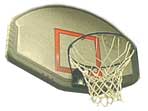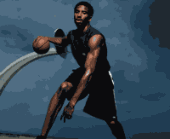Most people don’t realize that playing great basketball defense has a lot less to do with having speed and quick feet, and a lot more to do with having good anticipation, being aware of what’s going on around you, good body balance and basic fundamentals.
One simple reason many players never become good defenders is because they fail to learn the basic basketball defense fundamentals and techniques. Don’t let that be you! Take the time to study this page because anyone can become a great defender. If you really want it and invest time in it, you will get there.
Near the bottom of the page, you’ll also find an introduction to the most common defensive formations.
By the way, would you like to learn how to dramatically increase your focus on applying these basketball defense fundamentals without ingesting a pill or drink?
Basketball Defense Fundamentals
Basketball Defense Fundamental #1) Basic Stance
Keep your feet positioned as wide as your shoulders with your weight balanced on the balls of your feet. If you’re flat-footed, back on your heels or have your legs too close together, it’s hard to move quickly and you’ll find offensive players dribbling right around you. Keep your knees bent slightly with your butt low. Now, make sure you have one extended high to guard shots and passes and the other hand extended low on the ball.
Basketball Defense Fundamental #2) Focus On the Waist
If you want to avoid getting faked out, focus on a part of the offensive player’s body that doesn’t move. Many inexperienced players focus on the eyes, head and legs of their opponents. Or, they watch the ball. If you watch the ball, all the offender needs to do is fake a pass, fake a shot, or fake going one way and go the other way. Don’t do this or you’ll be sucking air as the offensive player goes in for the lay-up! Remember to watch your opponent’s mid-section because they can’t go anywhere without it. If they fake a pass or shot and then do something else, you’ll be right there because you’ll see the waist go where they really intend to go.
Basketball Defense Fundamental #3) Slide Side-to-Side
Position and footwork are two of the most important aspects of playing good basketball defense. Be sure to move side-to-side (laterally), without crossing your legs. As you slide, maintain your balance by keeping your feet as close to the width of your shoulders as possible. Also, avoid letting your feet to touch as you move.
Basketball Defense Fundamental #4) Be Aware of Tendancies
Becoming a good student of your opponent will turn you from an “OK” defensive player into a great one. You want to find out whether they are right-handed or left-handed. Do they like to drive to the hoop or do they prefer making jump shots? The key is to get your opponent doing the opposite of what they like. If they like making jumpers, try to make them drive. If they like to go to the left, make them go to the right.
An important element of this strategy is good footwork. If you’re trying to make an offender dribble to the left, keep your left foot slightly in front by dropping your right foot back. Stay on the balls of your feet. If they still try to go right, you’re in position to move in front of them. If you’re successful in making them go left (your right), you can move quickly that way. Reverse this basketball defense strategy to make them go right, of course.
Basketball Defense Fundamental #5) Guarding the Offender
There are two important fundamentals to guarding players without the ball: Stay between the player and the basket and try not to turn your back to the ball. If the player you’re guarding is on the right side of the floor and ball is on the left, raise your left hand and drop your right foot back a bit. Be sure your left arm is between your offender and the ball but don’t turn completely around or else your back will be to the ball. Keep your head up so you can see your opponent and the ball at al times.
Basketball Defense Fundamental #6) Shot Blocking
When blocking shots, always use the hand closest to the basket. If a player is driving in from the right side of the basket, you’ll use your left hand to block. This allows you to use the hand farthest from the offensive player’s body and lessens the possibility of committing a foul. You won’t be reaching across the offender’s body (which would increase your chances of fouling them).
Basketball Defense Fundamental #7) Switching
A switch occurs when two defenders switch players they are guarding in order to give each of them better defensive position. As an example, the player you are guarding goes to the left. Their teammate sets a pick and the player you’re guarding dribbles by them. Instead of you knocking the pick player over or going around them, your teammate, who was guarding the “pick” player, steps out in front of the player with the ball. You take over guarding the player without the ball and now you and your teammate have performed a switch.
Make sure that when your teammate steps out to meet the player with the ball that you keep your shoulders even with your teammate’s shoulders. If you drop back before your shoulders are at the same angle, the player with the ball can turn around and get by both of you.
Basketball Defense Fundamental #8) Low-Post Defense
The low post area is just to the left or right of the basket on or near the free-throw lane. This is where offensive players (usually the center or a forward) will stand waiting for the ball. They try to keep their defender behind them by spreading their legs wide and have an arm raised looking for the pass (they have their back to the basket). As a defensive player, the first thing you’re trying to prevent is the pass. Don’t try to get in front of the player. Move your body about three-quarters of the way in front with the arm farthest from the basket in the passing lane. Once the pass is in the air, drop back behind and get into good position to play defense.
Most Common Defensive Formations
Defensive Formation #1) Man-to-Man
Each of the five defensive players guards one of the five offensive players. Even if switching is used, each player is responsible for one offensive player at a time.
Defensive Formation #2) Zone
Each defender is responsible for guarding a certain area, or zone, instead of guarding a specific offensive player. The goal is to double-team the player with the ball. When an offensive player with the ball enters a zone between two defenders, those two defenders attack the dribbler while the other 3 defenders guard their areas.
Defensive Formation #3) 2-1-2 Zone
Two defenders are positioned above the foul line, one is in the lane and the other two are low on either side of the basket.
Defensive Formation #4) 2-3 Zone
Two defenders spread out from another above the foul line and the other three players are spread across the bottom half of the lane.
Defensive Formation #5) 1-3-1 Zone
One defender is positioned out front, three are across the foul line extended and the fifth is down under the basket. The player out front tries to force the dribbler right or left. As that player drives, another defender comes up for the double-team.
Defensive Formation #6) 2-2-1 Zone Press
This is usually a full-court defense. As soon as the ball is thrown inbounds after a basket, the defense starts guarding immediately (called full-court press). Again, the idea is to get two defenders double-teaming (trapping) the dribbler while the other three guard the rest of the floor.





